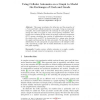Free Online Productivity Tools
i2Speak
i2Symbol
i2OCR
iTex2Img
iWeb2Print
iWeb2Shot
i2Type
iPdf2Split
iPdf2Merge
i2Bopomofo
i2Arabic
i2Style
i2Image
i2PDF
iLatex2Rtf
Sci2ools
ACRI
2010
Springer
2010
Springer
Using Cellular Automata on a Graph to Model the Exchanges of Cash and Goods
This paper investigates the behaviors and the properties of a "Give and Take" cellular automaton on a graph. Using an economical metaphor, this model implements the exchange of cash against goods, among the nodes of a graph G, with a local pricing mechanism. During the time evolution of this model, the strongly connected components (SCC) emerge, mimicking the creation of independent sub-markets. In the steady state, each SCC is characterized by a unique price obeying the supply and demand law for that sub-market. We also show that the distributions of cash and goods are proportional to the indegree of the cells, reproducing a Zipf's law of wealth distribution in case of a scalefree graph topology.
ACRI 2010 | Artificial Intelligence | Local Pricing Mechanism | Scalefree Graph Topology | Strongly Connected Components |
| Added | 20 Mar 2011 |
| Updated | 20 Mar 2011 |
| Type | Journal |
| Year | 2010 |
| Where | ACRI |
| Authors | Ranaivo Mahaleo Razakanirina, Bastien Chopard |
Comments (0)

